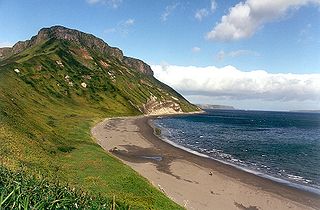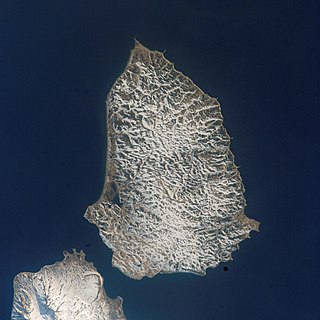
Sakhalin is an elongated island in Northeast Asia, located just 6.5 km (4.0 mi) off the southeastern coast of Khabarovsk Krai in Russia, and 40 kilometres (25 mi) north of Japan's Hokkaido. A marginal island of the West Pacific, Sakhalin divides the Sea of Okhotsk to its east from the Sea of Japan to its southwest. It is administered as part of Sakhalin Oblast and is the largest island of Russia, with an area of 72,492 square kilometres (27,989 sq mi). The island has a population of roughly 500,000, the majority of whom are Russians. The indigenous peoples of the island are the Ainu, Oroks, and Nivkhs, who are now present in very small numbers.

The Kuril Islands or Kurile Islands are a volcanic archipelago administered as part of Sakhalin Oblast in the Russian Far East. The islands stretch approximately 1,300 km (810 mi) northeast from Hokkaido in Japan to Kamchatka Peninsula in Russia, separating the Sea of Okhotsk from the north Pacific Ocean. There are 56 islands and many minor islets. The Kuril Islands consist of the Greater Kuril Chain and, at the southwest end, the parallel Lesser Kuril Chain. They cover an area of around 10,503.2 square kilometres (4,055.3 sq mi), with a population of roughly 20,000.

The Treaty of Saint Petersburg between the Empire of Japan and the Russian Empire was signed on 7 May 1875, and its ratifications exchanged at Tokyo on 22 August 1875. The treaty itself went into effect in 1877.

Sakhalin Oblast is a federal subject of Russia comprising the island of Sakhalin and the Kuril Islands in the Russian Far East. The oblast has an area of 87,100 square kilometers (33,600 sq mi). Its administrative center and largest city is Yuzhno-Sakhalinsk. As of the 2021 Census, the oblast has a population of roughly 500,000.
Subprefecture of Japan are a Japanese form of self-government which focuses on local issues below the prefectural level. It acts as part of the greater administration of the state and as part of a self-government system.

The Invasion of the Kuril Islands was the World War II Soviet military operation to capture the Kuril Islands from Japan in 1945. The invasion, part of the Soviet–Japanese War, was decided on when plans to land on Hokkaido were abandoned. The successful military operations of the Red Army at Mutanchiang and during the invasion of South Sakhalin created the necessary prerequisites for invasion of the Kuril Islands.

Shikotan, also known as Shpanberg or Spanberg, is an island in the Kurils administered by the Russian Federation as part of Yuzhno-Kurilsky District of Sakhalin Oblast. It is claimed by Japan as the titular Shikotan District, organized as part of Nemuro Subprefecture of Hokkaido Prefecture. The island's primary economic activities are fisheries and fishing, with the principal marine products being cod, crab, and kelp.

Korsakov is a town and the administrative center of Korsakovsky District of Sakhalin Oblast, Russia. It is located 42 kilometers (26 mi) south from Yuzhno-Sakhalinsk, at the southern end of Sakhalin Island, on the coast of the Salmon Cove in the Aniva Bay. The town has a population of 33,526 as of the 2010 census.
The Karafuto Fortress was the defensive unit formed by the Karafuto fortification installations, and the Karafuto detachment of Japanese forces, the 88th Division, created to defend against the Soviet invasion of South Sakhalin.
Between 1905 and 1945, the Japanese Empire administered the southern half of Sakhalin, using the name Karafuto (樺太). The area was designated a chō (廳), the same term given to Hokkaidō at the time. It is commonly referred to as Karafuto Prefecture in English. The prefecture was divided into 4 subprefectures, which in turn were subdivided into 11 districts, in turn divided into 41 municipalities

Yuri (Iurii) is an uninhabited island in the Habomai Islands sub-group of the Kuril Islands chain in the south of the Sea of Okhotsk, northwest Pacific Ocean. The island is uninhabited from 1945 after the Soviet invasion of the Kuril Islands and deportation of Japanese to Hokkaido. It is currently administered as part of Yuzhno-Kurilsky District, Sakhalin Oblast of the Russian Federation. Its name is derived from the Ainu language word for cormorant.

Shumshu is the easternmost and second-northernmost island of the Kuril Islands chain, which divides the Sea of Okhotsk from the northwest Pacific Ocean. The name of the island is derived from the Ainu language, meaning "good island". It is separated from Paramushir by the very narrow Second Kuril Strait in the northeast 2.5 kilometres (1.6 mi), and its northern tip is 11 kilometres (6.8 mi), from Cape Lopatka at the southern tip of the Kamchatka Peninsula. The island has a seasonal population of around 100 inhabitants.

Tyuleny Island is a small uninhabited island in the Sea of Okhotsk, to the east of Russia's Sakhalin Island, in Northeast Asia. It is also known by its Japanese name 海豹島 and has two widely used spelling alternatives: Tuleny and Tyuleniy.
Kiri no Hi (霧の火) is a Japanese television drama which originally aired on Nippon Television (NTV) on August 25, 2008. Directed by Nozomu Amamiya and with a screenplay by Yō Takeyama, it starred Etsuko Ichihara and Karina Nose. The production won a TV Drama Award at the 2008 Festival of the Arts of the Japanese Agency for Cultural Affairs.

Sakhalin Railway is a division of the Far Eastern Railway that primarily serves Sakhalin Island. Due to its island location, the railway is the second isolated 1520mm gauge network in Russia, like the Norilsk railway. The only main connection to the mainland is the Vanino–Kholmsk train ferry. The management is located at Yuzhno-Sakhalinsk.

The evacuation of Karafuto (Sakhalin) and the Chishima (kuril) islands refers to the events that took place during the Pacific theater of World War II as the Japanese population left these areas, to August 1945 in the northwest of the main islands of Japan.

The Japan–Russia border is the de facto maritime boundary that separates the territorial waters of the two countries. According to the Russia border agency, the border's length is 194.3 km (120.7 mi).

The Soviet invasion of South Sakhalin, also known as the Battle of Sakhalin, was the Soviet invasion of the Japanese portion of Sakhalin Island known as Karafuto Prefecture. The invasion was part of the Soviet–Japanese War, a minor campaign in the Asian Theatre during Second World War.
Karafuto Prefecture, commonly called South Sakhalin, was the Japanese administrative division corresponding to Japanese territory on southern Sakhalin island from 1905 to 1945.

The Sakhalin Regional Museum is a museum in Yuzhno-Sakhalinsk on the Russian island of Sakhalin. It is the largest museum in the Sakhalin Oblast. The Museum collects, researches, and displays materials relating to the natural history, archaeology, history, and ethnography of the region.























